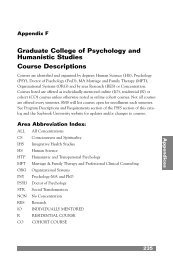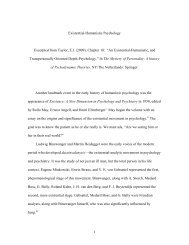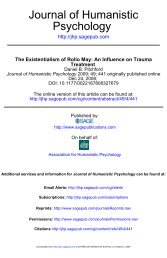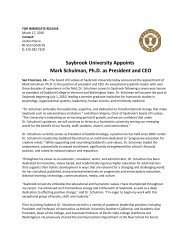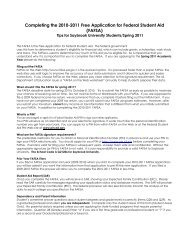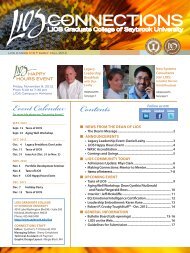A journal of creative thought and feeling published by LIOS ...
A journal of creative thought and feeling published by LIOS ...
A journal of creative thought and feeling published by LIOS ...
Create successful ePaper yourself
Turn your PDF publications into a flip-book with our unique Google optimized e-Paper software.
It rapidly became clear to me that she did not think <strong>of</strong> what had<br />
happened to her within her family as abusive, <strong>and</strong> yet she had recited<br />
a list <strong>of</strong> traumatic episodes, which <strong>by</strong> any <strong>of</strong> our current Washington<br />
laws would have clearly been considered sexual, physical <strong>and</strong> verbal<br />
abuse <strong>of</strong> a child. The perpetrators in her story were her mother <strong>and</strong> her<br />
older brother, with whom she had detailed a conflicted relationship.<br />
What followed over the next several months was a comprehensive<br />
exploration <strong>of</strong> her childhood traumas. Most <strong>of</strong> our goals were small<br />
<strong>and</strong> achievable within the context <strong>of</strong> a one-hour session. With each<br />
story, she began drawing pictures <strong>of</strong> her internal experience, creating<br />
a collection <strong>of</strong> artwork that was both stunning <strong>and</strong> revelational<br />
to her as her underst<strong>and</strong>ing evolved. We set small goals for her to<br />
accomplish between sessions as well, in order to address her depression:<br />
get outside for 20 minutes each day; call your daughter <strong>and</strong><br />
tell her you’re sorry about what happened to her; write a letter to<br />
the depression; <strong>and</strong> other small actions she could take in support <strong>of</strong><br />
her own healing. But the real breakthrough came about six months<br />
into our work together. She had been telling me about another<br />
incident that occurred with her brother as a child, when she<br />
suddenly stopped speaking <strong>and</strong> looked up at me in dismay. “He<br />
abused me.” In that moment, she understood beyond any doubt<br />
that the word “abuse” was not just a word that had happened to<br />
her daughter, it was her own experience. I waited. She whispered it<br />
again, “He abused me. Lots <strong>of</strong> times.” Tears began to run silently<br />
down her face, “That’s why I’m so messed up.”<br />
From that point forward, her symptoms began to recede dramatically<br />
as she reclaimed her life, <strong>and</strong> gave herself permission to be<br />
angry at her brother <strong>and</strong> the other family members who took no<br />
action to intervene on her behalf, <strong>and</strong> in some instances told her<br />
to “Suck it up. It’s not that big a deal.” At one point, she said, “I’ve<br />
been going to therapy for years. This is the first time I can see<br />
myself getting better. I can really see it.” I observed, “Maybe you<br />
were ready to do the work now. Maybe it just got safe enough.”<br />
What I <strong>of</strong>ten tell clients is that traumatic stress is a chameleon.<br />
It masquerades as other diagnoses—depression, anxiety, ADD/<br />
ADHD, sleep disorders, sexual dysfunction, to name a few.<br />
Treatment modalities that focus on symptom reduction, as<br />
required <strong>by</strong> most insurance plans, can be very effective for many<br />
people. But, if there’s a trauma history, it’s worth taking a look at<br />
the underlying causes for the symptoms, especially if conventional<br />
treatments do not appear to be working over time. For therapists,<br />
this creates some specific treatment issues.<br />
At the first session, we can be so focused on getting that diagnosis,<br />
<strong>and</strong> developing a clear treatment plan, that we neglect to ask the<br />
questions that will evoke the information needed to assess trauma<br />
as a possible precursor to the current symptoms. Our insurance<br />
company contracts require us to file claims with a clear diagnosis<br />
attached. Without the diagnosis, we do not get paid. And yet, if<br />
there is a trauma history <strong>and</strong> we don’t know it exists, we set up<br />
treatment modalities that are less than effective for the client.<br />
Consider the following ideas to build an assessment process that<br />
uncovers potential trauma in a client’s history.<br />
Consider allowing more time for assessments than a typical session.<br />
Taking a comprehensive family history is very difficult to complete<br />
in a 50-minute session. It can be helpful to assess a client over two<br />
sessions, or to do extended intake sessions, if your schedule allows.<br />
Avoid using the word “abuse” in your questions. If you ask many<br />
clients over the age <strong>of</strong> 40 whether or not they were abused as a<br />
child, they may tell you they were not, because their childhood<br />
family culture may not have recognized family dynamics as abusive.<br />
Thus, they do not label their experience as abuse. Instead, consider<br />
asking questions like: “How did your parents discipline the children<br />
in your home as a child?” “Was there anyone you were afraid <strong>of</strong> as a<br />
child?” “Were there things no one was allowed to talk about when<br />
you were a child?” “How did your family h<strong>and</strong>le secrets?”<br />
Ask about current safety issues. For instance, you might ask: “Is<br />
there any reason I should be concerned about your safety in your<br />
current living situation?” “Are there any dynamics going on between<br />
you <strong>and</strong> someone else in your home that you think might be<br />
contributing to your <strong>feeling</strong>s <strong>of</strong> depression/anxiety/inability to<br />
concentrate?” Many victims <strong>of</strong> childhood abuse are involved<br />
in abusive relationships as adults. The shame <strong>of</strong> these relationships<br />
keeps ongoing victims from being willing to admit they are in<br />
abusive dynamics at home. However, if you tie your questions to<br />
concern about their well-being <strong>and</strong> possible causes <strong>of</strong> symptoms,<br />
they are frequently more willing to speak about their situations.<br />
Even if they don’t answer the questions during the assessment,<br />
they are more likely to realize you are open to hearing about these<br />
experiences, <strong>and</strong> to think <strong>of</strong> you as a resource when they are ready<br />
to talk about it. If safety issues are current problems, then it will be<br />
imperative to develop a safety plan prior to doing any other work. A<br />
client whose home life is inherently unstable <strong>and</strong> volatile is unlikely<br />
to be able to tolerate in-depth exploration <strong>of</strong> her trauma history.<br />
Consider your diagnosis a working diagnosis, <strong>and</strong> be ready to<br />
change it if new information emerges. New clinicians, in particular,<br />
can get very focused on getting the “right” diagnosis, rather than<br />
seeing a diagnosis as a fluid concept that can evolve over time. It<br />
is easy to get stuck thinking <strong>of</strong> a client as “depressed, 52-year-old,<br />
Caucasian woman,” instead <strong>of</strong> remaining open to what you do not<br />
yet know about her. In spite <strong>of</strong> the rigor with which the DSM was<br />
Photo <strong>by</strong> John McConnell, M.A., <strong>LIOS</strong>, 1996; Images <strong>of</strong> Leadership Project<br />
15



